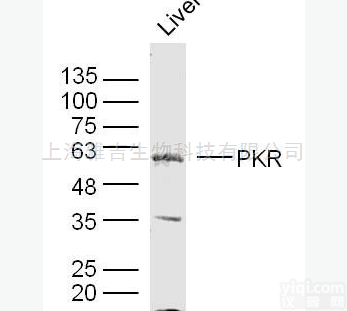神经生长因子(NGF)真核蛋白HZA105Hu61 100ug Eukaryotic Nerve Growth Factor (NGF) Organism Species: Homo sapiens (Human) Instruction manual FOR IN VITRO USE AND RESEARCH USE ONLY NOT FOR USE IN CLINICAL DIAGNOSTIC PROCEDURES 11th Edition (Revised in May, 2016) [ PROPERTIES ] Source: Eukaryotic expression. Host: 293F cell Residues: Glu19~Arg239 Tags: N-terminal His Tag Homology: Mouse 85%, rat 86% Tissue Specificity: Serum. Subcellular Location: 神经生长因子(NGF)真核蛋白Secreted. Purity: >95% Endotoxin Level: <1.0EU per 1μg (determined by the LAL method). Traits: Freeze-dried powder Buffer Formulation: 20mM Tris, 150mM NaCl, pH8.0, containing 1mM EDTA, 1mM DTT, 5%Trehalose and Proclin300. Original Concentration: 200ug/mL Predicted isoelectric point: 9.9 Predicted Molecular Mass: 26.3kDa Accurate Molecular Mass: 40kDa as determined by SDS-PAGE reducing conditions. Applications: SDS-PAGE; WB; ELISA; IP; CoIP; EMSA; Reporter Assays;神经生长因子(NGF)真核蛋白 Purification; Amine Reactive Labeling. (May be suitable for use in other assays to be determined by the end user.) Phenomenon explanation: The possible reasons that the actual band size differs from the predicted are as follows: 1. Splice variants: Alternative splicing may create different sized proteins from the same gene. 2. Relative charge: The composition of amino acids may affects the charge of the protein. 3. Post-translational modification: Phosphorylation, glycosylation, methylation etc. 4. Post-translation cleavage: Many proteins are synthesized as pro-proteins, and then cleaved to give the active form. 5. Polymerization of the target protein: 神经生长因子(NGF)真核蛋白Dimerization, multimerization etc. [ USAGE ] Reconstitute in 20mM Tris, 150mM NaCl (pH8.0) to a concentration of 0.1-1.0 mg/mL. Do not vortex [ STORAGE AND STABILITY ] Storage: Avoid repeated freeze/thaw cycles. Store at 2-8 oC for one month. Aliquot and store at -80 oC for 12 months. Stability Test: The thermal stability is described by the loss rate. The loss rate was determined by accelerated thermal degradation test, that is, incubate the protein at 37 oC for 48h, and no obvious degradation and precipitation were observed.The loss rate is less than 5% within the expiration date under appropriate storage condition. 神经生长因子(NGF)真核蛋白
HZ129Fi01 组织金属蛋白酶YZ因子3(TIMP3)重组蛋白 Recombinant Tissue Inhibitors Of Metalloproteinase 3 (TIMP3)
Danio rerio (Zebrafish)
HZ129Ga01 组织金属蛋白酶YZ因子3(TIMP3)重组蛋白 Recombinant Tissue Inhibitors Of Metalloproteinase 3 (TIMP3)
Chicken (Gallus)
HZ129Hu01 组织金属蛋白酶YZ因子3(TIMP3)重组蛋白 Recombinant Tissue Inhibitors Of Metalloproteinase 3 (TIMP3)
Homo sapiens (Human)
HZ129Mu01 组织金属蛋白酶YZ因子3(TIMP3)重组蛋白 Recombinant Tissue Inhibitors Of Metalloproteinase 3 (TIMP3)
Mus musculus (Mouse)
HZ129Po01 组织金属蛋白酶YZ因子3(TIMP3)重组蛋白 Recombinant Tissue Inhibitors Of Metalloproteinase 3 (TIMP3)
Sus scrofa; Porcine (Pig)
HZ129Ra01 组织金属蛋白酶YZ因子3(TIMP3)重组蛋白 Recombinant Tissue Inhibitors Of Metalloproteinase 3 (TIMP3)
Rattus norvegicus (Rat)
HZ129Rb01 组织金属蛋白酶YZ因子3(TIMP3)重组蛋白 Recombinant Tissue Inhibitors Of Metalloproteinase 3 (TIMP3)
Oryctolagus cuniculus (Rabbit)
HZ129Si01 组织金属蛋白酶YZ因子3(TIMP3)重组蛋白 Recombinant Tissue Inhibitors Of Metalloproteinase 3 (TIMP3)
Rhesus monkey (Simian)
HZ130Bo01 组织金属蛋白酶YZ因子4(TIMP4)重组蛋白 Recombinant Tissue Inhibitors Of Metalloproteinase 4 (TIMP4)
Bos taurus; Bovine (Cattle)
HZ130Hu01 组织金属蛋白酶YZ因子4(TIMP4)重组蛋白 Recombinant Tissue Inhibitors Of Metalloproteinase 4 (TIMP4)
Homo sapiens (Human)
HZ130Mu01 组织金属蛋白酶YZ因子4(TIMP4)重组蛋白 Recombinant Tissue Inhibitors Of Metalloproteinase 4 (TIMP4)
Mus musculus (Mouse)
HZ130Po01 组织金属蛋白酶YZ因子4(TIMP4)重组蛋白 Recombinant Tissue Inhibitors Of Metalloproteinase 4 (TIMP4)
Sus scrofa; Porcine (Pig)
 NGF 神经生长因子(NGF)真核蛋白
NGF 神经生长因子(NGF)真核蛋白
 U2小核核糖核蛋白辅助因子(U2AF1)抗体
U2小核核糖核蛋白辅助因子(U2AF1)抗体
 U2小核核糖核蛋白辅助因子(U2AF1)
U2小核核糖核蛋白辅助因子(U2AF1)
 U2小核核糖核蛋白辅助因子(U2AF1)
U2小核核糖核蛋白辅助因子(U2AF1)
 神经生长因子(NGF)真核蛋白
神经生长因子(NGF)真核蛋白
 转化生长因子β诱导蛋白3抗体(半胱氨酸和丝氨酸富含核蛋白 / 转化生长因子β诱导蛋白3抗体(半胱氨酸和丝氨酸富含核蛋白1)
转化生长因子β诱导蛋白3抗体(半胱氨酸和丝氨酸富含核蛋白 / 转化生长因子β诱导蛋白3抗体(半胱氨酸和丝氨酸富含核蛋白1)
 转化生长因子β诱导蛋白3抗体(半胱氨酸和丝氨酸富含核蛋白 / 转化生长因子β诱导蛋白3抗体(半胱氨酸和丝氨酸富含核蛋白1)
转化生长因子β诱导蛋白3抗体(半胱氨酸和丝氨酸富含核蛋白 / 转化生长因子β诱导蛋白3抗体(半胱氨酸和丝氨酸富含核蛋白1)
 神经生长因子(NGF)真核蛋白
神经生长因子(NGF)真核蛋白
 神经生长因子(NGF)真核蛋白
神经生长因子(NGF)真核蛋白
 转移生长因子诱导核蛋白1 / 转移生长因子诱导核蛋白1抗体
转移生长因子诱导核蛋白1 / 转移生长因子诱导核蛋白1抗体
 核因子κB受体激活因子配体(RANkL)真核蛋白
核因子κB受体激活因子配体(RANkL)真核蛋白
 核组装因子1核糖核蛋白抗体NAF1特异性
核组装因子1核糖核蛋白抗体NAF1特异性